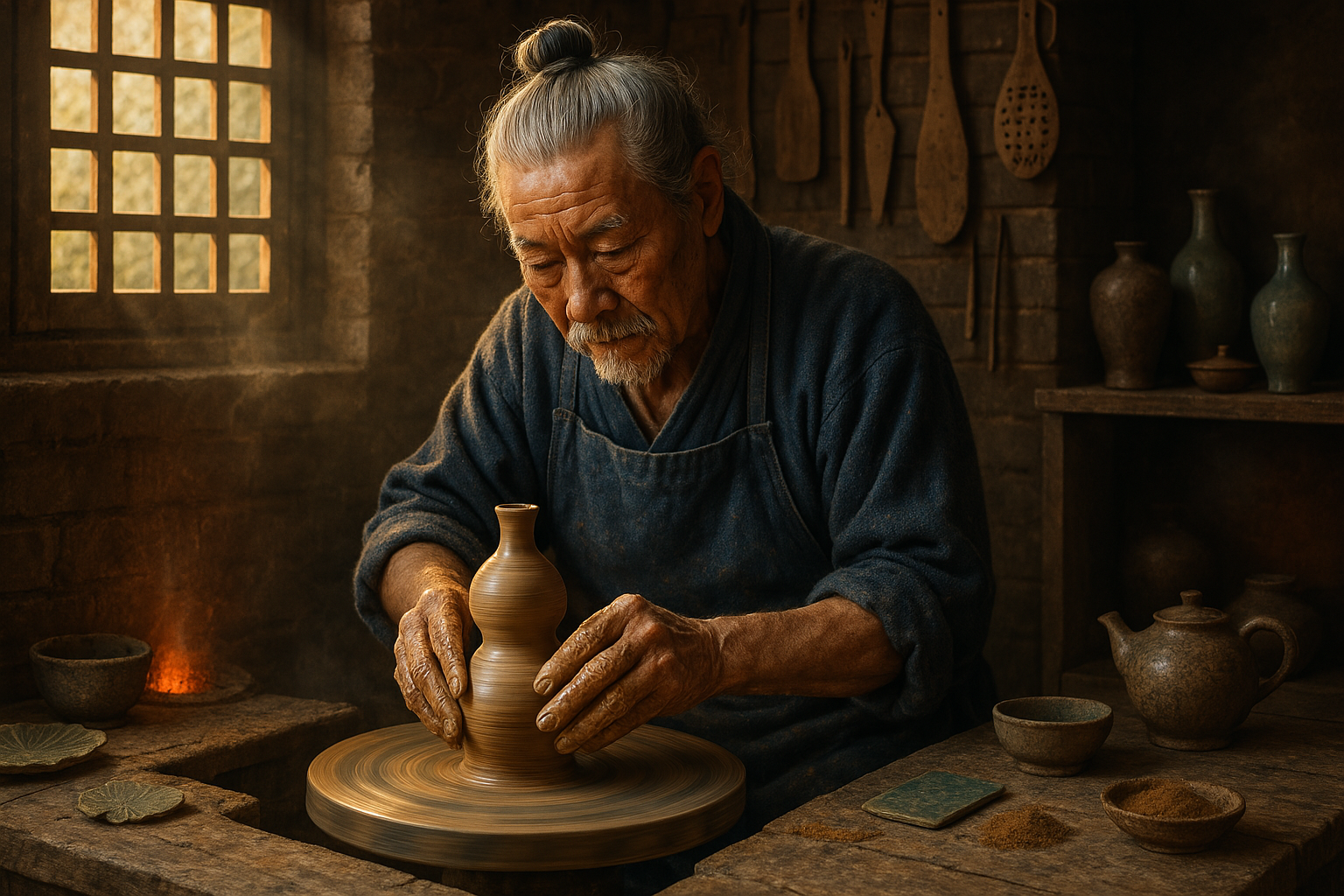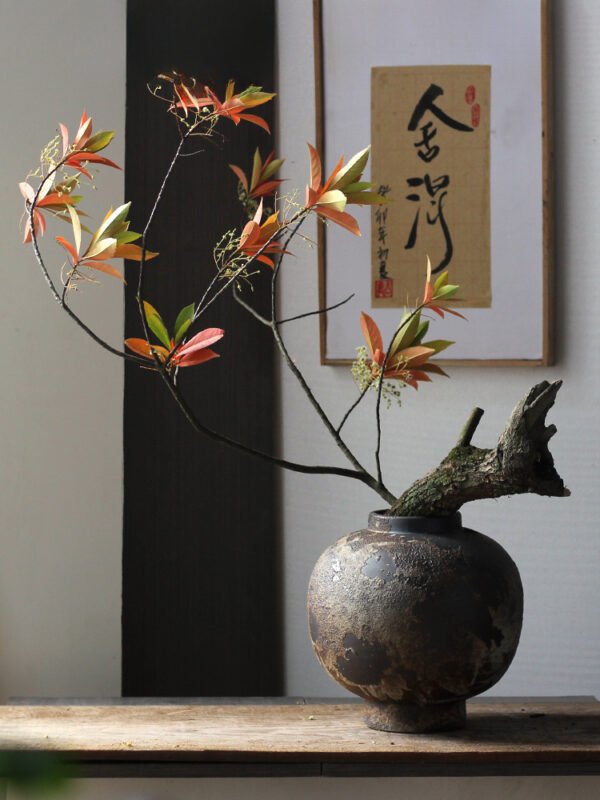Chapter 1: Memories of Clay and Fire
One scorching summer, I stumbled upon a thick book on ceramic history. As I flipped through its pages, I saw traces of ancient craftsmanship—Chinese porcelain, Greek black-figure pottery, Egyptian faience. These weren’t just objects; they were echoes of history, shaped by time and imprinted with civilization’s mark.
The story of ceramics begins with a handful of clay, awakened by fire, crossing millennia to reach us today. In our Vases & Jars collection, we honor these traditions, bringing ancient artistry into modern life.
Chapter 2: China’s Porcelain—The Glow of Moonlight
Over 2,000 years ago, Chinese artisans mastered an extraordinary craft—porcelain. White as frost, thin as a cicada’s wing, and with a bell-like resonance when tapped, it was a marvel of its time. Kaolin clay, mixed with quartz and feldspar, was fired at over 1,200°C, creating some of the finest ceramics in history.
“Have you ever seen real Tang dynasty porcelain?” my uncle once asked, pointing at a photo of a vase with a soft, jade-like glaze. Later, in the Yuan dynasty, blue-and-white porcelain emerged, with deep cobalt patterns flowing across a white surface—an iconic aesthetic that spread across the world.
In our Ceramic Collection, we carry forward this Eastern elegance—every glaze and curve echoes the skill of ancient masters.
Chapter 3: Greece—A Dance of Black and Red
In ancient Greece, pottery was more than utility; it was storytelling. Artisans painted gods, warriors, and epic voyages onto vases, first in black against red clay, and later reversing the technique—red figures against black backgrounds.
This wasn’t just a change in style; it was a visual revolution. The firing process required three stages, with careful control over the kiln’s oxygen levels to achieve the desired contrast. These vases, once filled with olive oil and wine, now rest behind museum glass, whispering myths of the past.
Our Vases & Jars embrace this classical charm—strong lines, elegant curves, as if they once held wine for an ancient feast.
Chapter 4: Egypt—Echoes of the Nile
Over 3,000 years ago, Egyptian artisans shaped pottery from the rich silt of the Nile. Their creations ranged from earthy browns to brilliant blues and greens, some adorned with a lustrous glaze known as faience—a blend of crushed quartz and minerals.
“Why is this vase so bright?” my younger brother once asked in a museum, pointing at a turquoise artifact. I explained that the Egyptians didn’t just shape clay; they transformed it, fusing minerals in fire to create shimmering surfaces.
Our Jars & Vases borrow from this legacy—solid craftsmanship with soft glazes that catch the light, reminiscent of those ancient artisans.
Chapter 5: Mesopotamia—The First Marks of Civilization
Long before China’s porcelain or Greece’s painted pottery, Mesopotamian artisans were crafting ceramics—5,000 years ago, along the banks of the Tigris and Euphrates. Their methods were rudimentary—coiling strips of clay by hand and smoothing them into sturdy vessels, as the potter’s wheel had yet to be invented.
Later, they pressed patterns into the clay—zigzag lines, star shapes, wavelike symbols—some of the earliest artistic expressions of humanity.
Our Ceramic Collection preserves this raw aesthetic—textured jars, vases that feel like they’ve witnessed centuries of history.
Chapter 6: Japan—The Beauty of Imperfection
Japanese ceramics whisper rather than shout. Over 10,000 years ago, Jomon artisans pressed rope patterns into clay, creating textured surfaces reminiscent of ripples on water.
By the 10th century, Japan had learned porcelain techniques from China but retained its distinct philosophy—embracing imperfection. The concept of “wabi-sabi” finds beauty in irregularities, favoring handmade forms over mechanical precision.
“Feel this,” a friend once said, handing me a book with a photo of a gray, uneven vase. Its surface was rough yet tranquil. That’s Japanese pottery—grounded, simple, profound.
Our Vases & Jars channel this spirit—organic, balanced, deeply human.
Wabi-Sabi Coarse Pottery Vase – Ancient Series| Handcrafted Antique Zen Aesthetic
One Percent Clay Wabi-Sabi Coarse Pottery Vase – Ancient Series
Deep gray-white coarse pottery, weathered like an ancient relic, adorned with Zen-inspired serenity. A masterpiece of craftsmanship—place it indoors and feel the raw essence of nature and the whispered echoes of old temples.
Chapter 7: Rome—Practical Elegance
The Romans, ever pragmatic, took Greek pottery and streamlined it. Around 500 BC, they mass-produced red-clay jars and amphorae, using them for everything from olive oil storage to water transport. Their technique was efficient: a single firing, a polished slip, and sometimes a stamped maker’s mark—the earliest form of branding.
I once held a Roman jar at an antique market—sturdy, unadorned, yet undeniably elegant. Our Jars & Vases embrace this durability and timeless design, bringing a touch of history into modern homes.
Chapter 8: India—A Celebration of Color
India’s ceramic tradition is as vibrant as its culture. As early as 2500 BC, the artisans of the Indus Valley were shaping clay by hand, painting it in bold reds, blacks, and yellows—adorned with motifs of fish, trees, and geometric patterns.
“Why are Indian pots so colorful?” my sister once asked while browsing an online gallery. “Because color is life,” I replied. In India, every shade carries meaning—prosperity, devotion, celebration.
Our Ceramic Collection carries this warmth—earthy tones, rich textures, ready to bring a burst of heritage into your space.
Chapter 9: The Threads That Connect Them
✅ China, masters of refinement and purity
✅ Greece, storytellers in clay
✅ Egypt, alchemists of river silt
✅ Mesopotamia, pioneers of decoration
✅ Japan, philosophers of imperfection
✅ Rome, champions of function
✅ India, artists of color
Though their approaches differed, their roots were the same—clay, fire, the human hand. Our Vases & Jars collection is a tribute to these enduring traditions.
Chapter 10: Bringing History into Your Home
Ancient craftsmanship is not just history—it’s alive. The spinning potter’s wheel, the flicker of a kiln, the brush of a glaze—these time-honored methods still shape what we create today.
As I look at the celadon vase on my table, I think of Tang dynasty artisans. The sturdy red jar by my sink reminds me of Roman practicality.
📌 Browse our collection and bring a touch of history into your space. These are not just vases and jars; they are stories waiting to be told.


